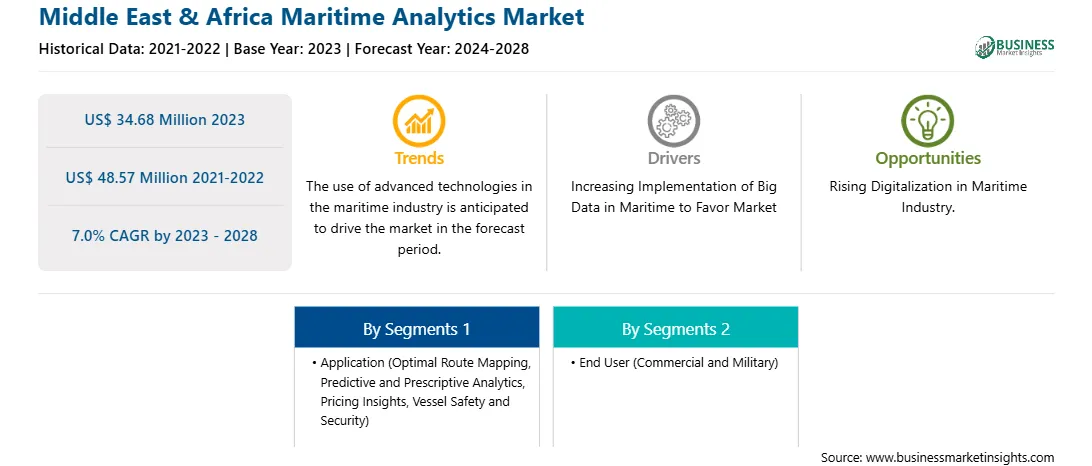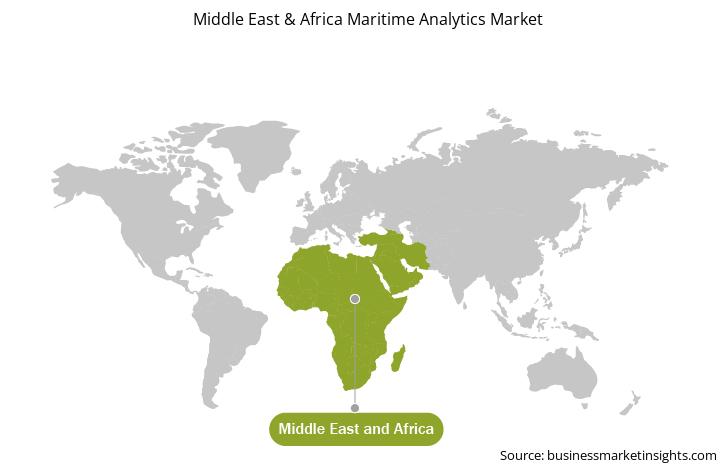Middle East & Africa Maritime Analytics Market
No. of Pages: 128 | Report Code: TIPRE00015408 | Category: Technology, Media and Telecommunications
No. of Pages: 128 | Report Code: TIPRE00015408 | Category: Technology, Media and Telecommunications
The maritime industry is investing proactively in advanced technology solutions to bring digital transformation and to become more efficient and sustainable. Artificial intelligence (AI), big data, blockchain, cloud computing, cyber security, digital twin, internet of things (IoT), machine learning, and robotic technologies are some of the key technologies that are contributing towards the advancement of global maritime industry. Furthermore, increase in collaborations between maritime industry stakeholders and technology solution providers, rise in the number of maritime analytics solution providers, investments by maritime companies in big data infrastructure development, and growth of funding opportunities are some of the other factors projected to penetrate the growth of maritime analytics market in the future. Artificial intelligence (AI) is being utilized in the shipping industry to reduce staff and maintenance, increase automation, achieve better navigation and safety, and minimize human errors. IBM and Google are among the key companies helping the shipping sector with process automation. The maritime industry uses AI for an array of applications, including autonomous navigation, route optimization, and predictive maintenance. New players are leveraging the processed information generated through sensors, public information systems, and asset tracking systems to enhance and optimize vessel efficiency and operational costs. Additionally, new entrants are offering digital twins of ships, ports, and fleets utilizing AI to monitor operations continuously while enhancing port and vessel management.
The maritime analytics market in the Middle East & Africa is further segmented into South Africa, Saudi Arabia, and the UAE. The region is expected to witness rapid commercialization and industrialization, which would also boost the growth of various sectors. The Gulf countries are economically developed, while the African countries are yet to match up to these countries' economic conditions. With large-scale export and import business of oil and gas in the Middle East region, penetration of maritime analytics is anticipated to grow. New orders for gas tanker ships are increasing from the region, showcasing the growth in the oil and gas trade. The use of analytics and predictive maintenance is effective for monitoring engine performance and fuel consumption on vessels. For instance, in 2017 Topaz Energy & Marine has revealed digitalization and offshore communications technology on their vessels to enhance business operations and crew welfare. Topaz is connecting its fleet of up to 110 vessels to a digital platform through Orange Business Services' Maritime Connect solution. Moreover, it invested in vessel tracking technology to monitor fleets in terms of planning maintenance, fuel efficiency, and spending limited on dry-docking. The trend of surging technological investments and developments like these by companies is anticipated to play a greater role in influencing market growth in the Middle East & Africa.
Strategic insights for the Middle East & Africa Maritime Analytics provides data-driven analysis of the industry landscape, including current trends, key players, and regional nuances. These insights offer actionable recommendations, enabling readers to differentiate themselves from competitors by identifying untapped segments or developing unique value propositions. Leveraging data analytics, these insights help industry players anticipate the market shifts, whether investors, manufacturers, or other stakeholders. A future-oriented perspective is essential, helping stakeholders anticipate market shifts and position themselves for long-term success in this dynamic region. Ultimately, effective strategic insights empower readers to make informed decisions that drive profitability and achieve their business objectives within the market.

| Report Attribute | Details |
|---|---|
| Market size in 2023 | US$ 34.68 Million |
| Market Size by 2028 | US$ 48.57 Million |
| Global CAGR (2023 - 2028) | 7.0% |
| Historical Data | 2021-2022 |
| Forecast period | 2024-2028 |
| Segments Covered |
By Application
|
| Regions and Countries Covered | Middle East and Africa
|
| Market leaders and key company profiles |
The geographic scope of the Middle East & Africa Maritime Analytics refers to the specific areas in which a business operates and competes. Understanding local distinctions, such as diverse consumer preferences (e.g., demand for specific plug types or battery backup durations), varying economic conditions, and regulatory environments, is crucial for tailoring strategies to specific markets. Businesses can expand their reach by identifying underserved areas or adapting their offerings to meet local demands. A clear market focus allows for more effective resource allocation, targeted marketing campaigns, and better positioning against local competitors, ultimately driving growth in those targeted areas.

The Middle East & Africa maritime analytics market is segmented into application, end user, and country.
Based on application, the maritime analytics market is divided into optimal route mapping, predictive & prescriptive analytics, pricing insights, vessel safety & security, and others. The predictive & prescriptive analytics segment held the largest market share in 2023.
Based on end user, the market is bifurcated into commercial and defense. The commercial segment held the largest market share in 2023.
Based on country, the Middle East & Africa maritime analytics market is segmented into Saudi Arabia, South Africa, the UAE, and the Rest of Middle East & Africa. Saudi Arabia dominated the market in 2023.
ShipNet; Kpler; OrbitMI, Inc.; Nordic IT; LgMAR; and Windward Ltd are the leading companies operating in the Middle East & Africa maritime analytics market.
The Middle East & Africa Maritime Analytics Market is valued at US$ 34.68 Million in 2023, it is projected to reach US$ 48.57 Million by 2028.
As per our report Middle East & Africa Maritime Analytics Market, the market size is valued at US$ 34.68 Million in 2023, projecting it to reach US$ 48.57 Million by 2028. This translates to a CAGR of approximately 7.0% during the forecast period.
The Middle East & Africa Maritime Analytics Market report typically cover these key segments-
The historic period, base year, and forecast period can vary slightly depending on the specific market research report. However, for the Middle East & Africa Maritime Analytics Market report:
The Middle East & Africa Maritime Analytics Market is populated by several key players, each contributing to its growth and innovation. Some of the major players include:
The Middle East & Africa Maritime Analytics Market report is valuable for diverse stakeholders, including:
Essentially, anyone involved in or considering involvement in the Middle East & Africa Maritime Analytics Market value chain can benefit from the information contained in a comprehensive market report.